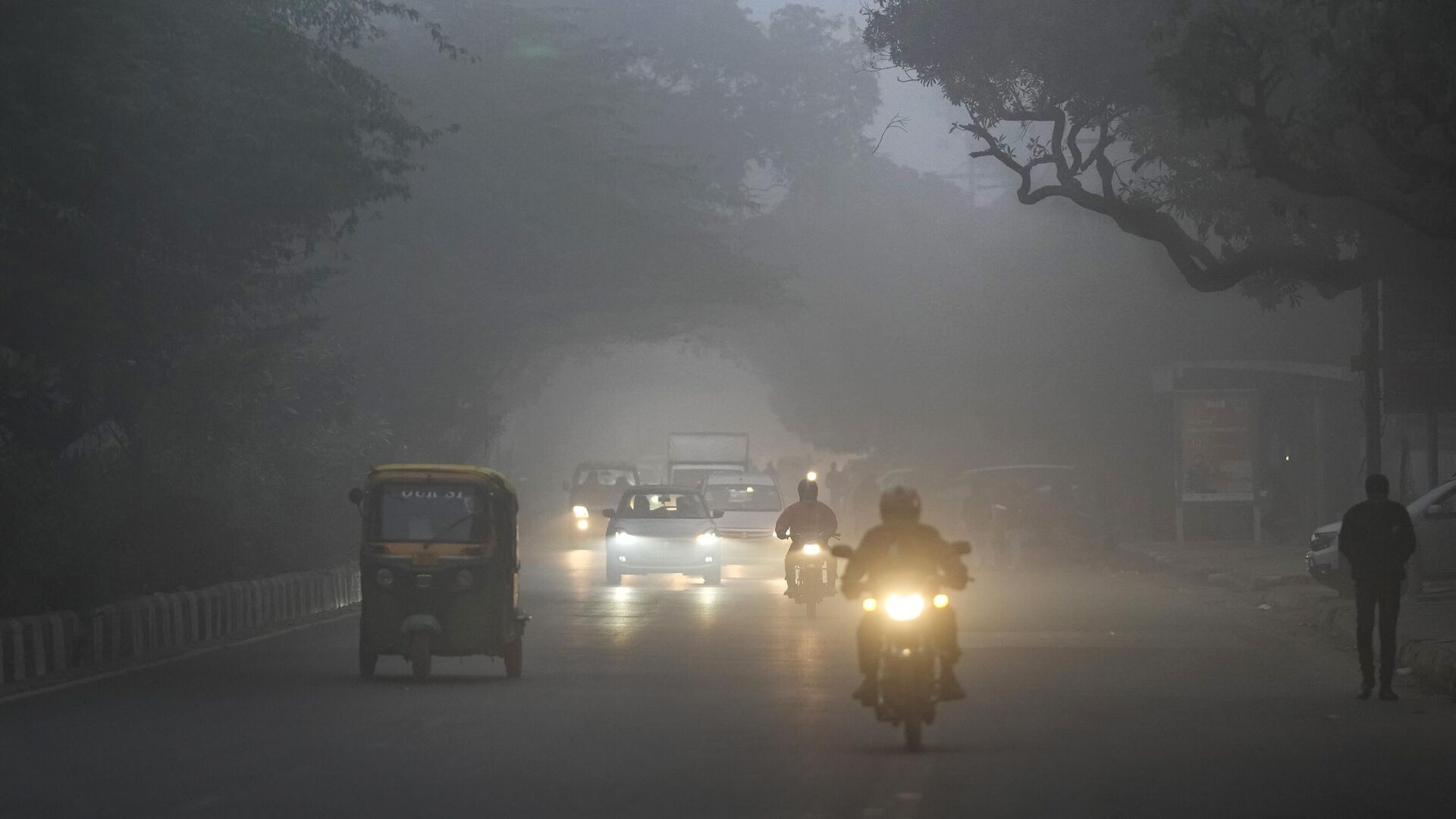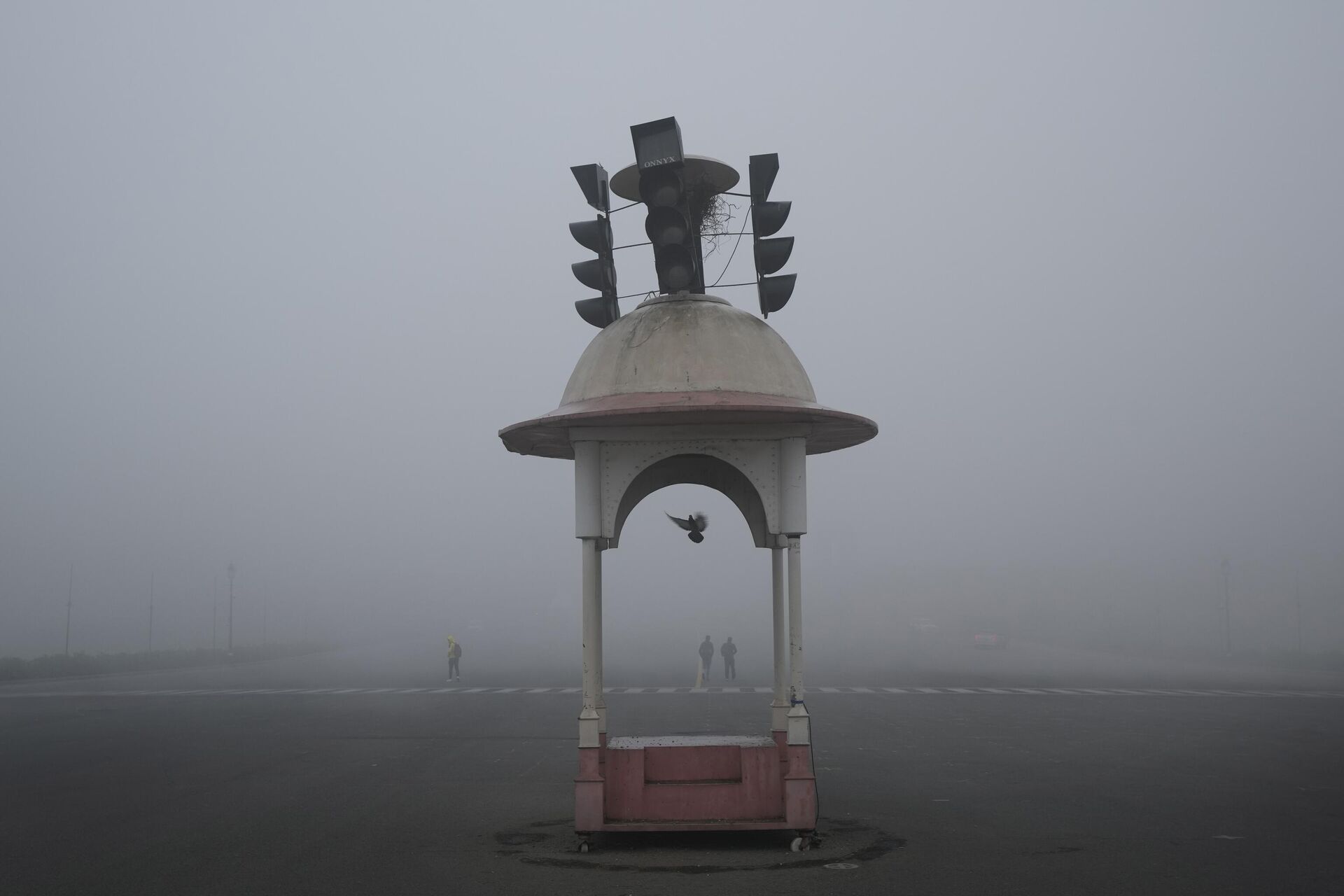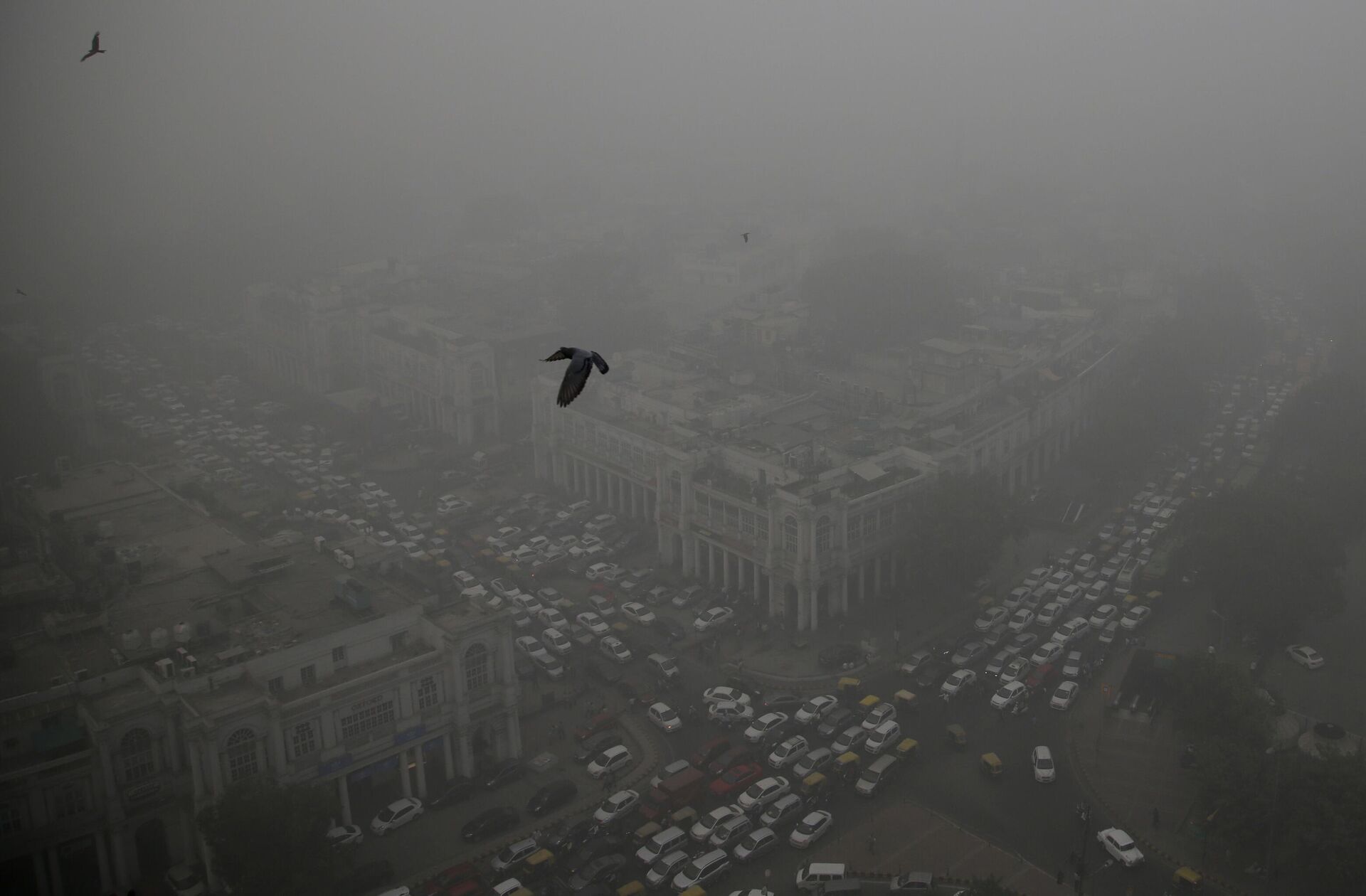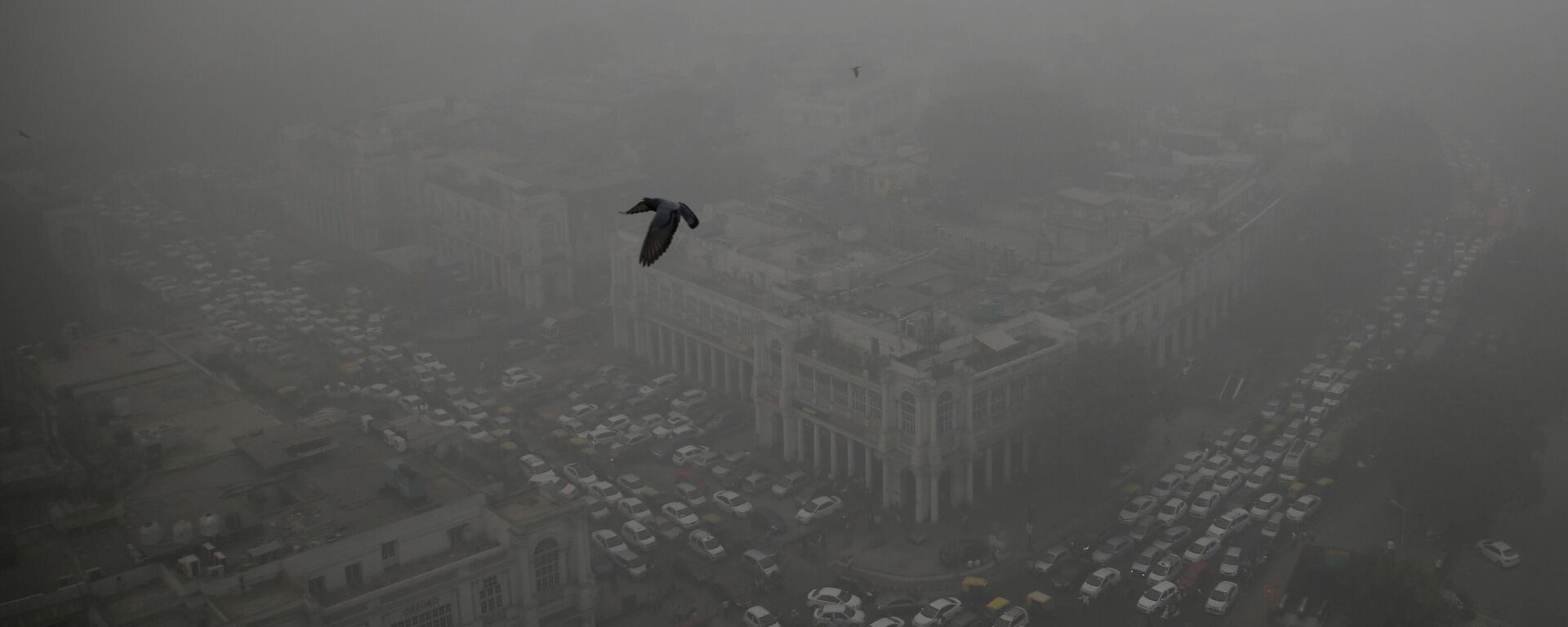https://sputniknews.in/20231105/too-toxic-to-breathe-delhi-chokes-on-air-pollution-5256475.html
Too Toxic to Breathe: Delhi Chokes on Air Pollution
Too Toxic to Breathe: Delhi Chokes on Air Pollution
Sputnik India
Delhi's air quality index is dangerously close to 100 now that smog season has begun.
2023-11-05T14:53+0530
2023-11-05T14:53+0530
2023-11-05T19:59+0530
world news
delhi
india
punjab
arvind kejriwal
bharatiya janata party (bjp)
the world health organization (who)
aam aadmi party (aap)
air pollution
plastic pollution
https://cdn1.img.sputniknews.in/img/07e6/0c/14/159726_0:320:3073:2048_1920x0_80_0_0_63911b24759f9c620f28ccc21ce5799a.jpg
Delhi's air quality index is dangerously close to 100 now that smog season has begun. Regulating this annual toxic scourge on life has progressed slowly thus far. In 2023, the IQAir Index found that Delhi has the highest amount of polluted air of any city on the globe.Ironically, billionaires, businessmen, construction corporations, and industrial stakeholders in Delhi continue business as usual despite the severe consequences of climate change and air pollution. Buildings are being erected, gasoline is being burned, diesel is being used, and vehicles are being sold, all while they ignore the negative impacts on air quality and the environment in favor of making a profit. Although, last year, Delhi was declared the second most polluted city in the world, there has been no progress, and preventative measures are being taken by the government.After this, nonetheless, in Delhi, civic organizations have taken steps to reduce pollution. The Municipal Corporation of Delhi has dispatched 517 teams, with a total of 1,119 policemen, to keep an eye on things like open burning, illegal disposal of C&D trash, construction site inspections, and road dust.Meanwhile, the ruling Aam Aadmi Party (AAP), Bharatiya Janata Party (BJP), and Congress hurled insults over the grave scenario. Reena Gupta, an AAP spokesperson, claimed that although the governments in Delhi and Punjab are taking action, the governments in Haryana and Uttar Pradesh, which are dominated by the BJP, are doing nothing. It was "carelessness" on the part of Delhi Chief Minister Arvind Kejriwal, according to BJP national spokesperson Gaurav Bhatia.Causes of Current Air PollutionAccording to the region's Commission for Air Quality Management, "unfavorable meteorological conditions, sudden increases in farm fire incidents, and northwesterly winds moving pollutants to Delhi are the major causes of sudden spikes in AQI." Typically, crop stubble burning in the states of Punjab and Haryana, which are a portion of the agriculture belt that borders New Delhi, contributes to an increase in air pollution in the capital city of India starting around November.However, Justice Surya Kant said, "It has become a trend for everyone to attack the farmers. Have you seen the destruction that the burning of firecrackers has caused in Delhi over the past week?A Bird's Eye View of Delhi Air PollutionAccording to a World Health Organization assessment of 1,650 global cities and a survey of 7,000 global cities conducted by the Health Effects Institute in the United States in August 2022, Delhi, the capital territory of India, has the worst air quality of any large city worldwide. The areas surrounding Delhi are also impacted. Air pollution is the sixth leading cause of death in India, with an annual death toll of around 2 million people. India has the world's highest fatality rate from chronic respiratory disorders and asthma, according to the WHO. Air pollution in Delhi is so bad that it has permanently harmed the lungs of 2.2 million youngsters, or half of the city's youth.Ramifications of Air PollutionResidents reported irritation in their throats and eyes on Friday, when the AQI at several city monitoring stations was approximately 480. This was attributed to the dense gray air.Globally, air pollution is one of the biggest causes of death, particularly for young people. Those who are already at risk, such as young children, the elderly, and those with underlying medical disorders like asthma or heart disease, are disproportionately affected by poor air quality. Additionally, it may impede a child's lung development. Dr Randeep Guleria, a pulmonologist and former director of the All India Institute of Medical Sciences (AIIMS) in New Delhi, has observed that the environment stunts a child's ability to develop their lungs.Severe weather events can lead to food insecurity, displacement, air pollution, and illnesses in one of the poorest and most populous subregions in the world. Furthermore, breathing in contaminated air exacerbates respiratory infections, lung cancer, and pulmonary and cardiovascular diseases, and air pollution is a major global cause of death. The world's unquenchable desire for energy has only intensified, leading to an increase in wildfires and the creation of new, unequally distributed hazards, even as carbon emissions have dropped. Like many other public health issues, the effects of toxic air vary among individuals based on their socioeconomic position and place of residence. Winter has arrived in South Asia, bringing with it smog, toxic air, and respiratory problems. However, India is the nation most at risk from air pollution and climate change.ConclusionIt is a wakeup call for the Indian government to fight this plague decisively, effectively, and timely. For this purpose, political and social commitments are needed to address air pollution. Implementation of fines, penalties, and punishments on violators is essential for reducing Delhi air pollution. Governments should promote public transportation and renewable energy. Individuals can reduce their carbon footprint, switch to renewable energy, and use public transport.The United Nations General Assembly (UNGA) nevertheless declared: “Each individual has the right to live in a clean and healthy environment”.
https://sputniknews.in/20231105/bjp-reacts-sharply-after-delhi-minister-blames-haryana-uttar-pradesh-for-air-pollution-5251644.html
delhi
india
punjab
Sputnik India
feedback.hindi@sputniknews.com
+74956456601
MIA „Rossiya Segodnya“
2023
Muhammad Sharif
https://cdn1.img.sputniknews.in/img/07e7/0b/05/5257054_0:0:443:444_100x100_80_0_0_b8bd2af32be62a6eecdb4a84c7fd978f.jpg
Muhammad Sharif
https://cdn1.img.sputniknews.in/img/07e7/0b/05/5257054_0:0:443:444_100x100_80_0_0_b8bd2af32be62a6eecdb4a84c7fd978f.jpg
News
en_IN
Sputnik India
feedback.hindi@sputniknews.com
+74956456601
MIA „Rossiya Segodnya“
Sputnik India
feedback.hindi@sputniknews.com
+74956456601
MIA „Rossiya Segodnya“
Muhammad Sharif
https://cdn1.img.sputniknews.in/img/07e7/0b/05/5257054_0:0:443:444_100x100_80_0_0_b8bd2af32be62a6eecdb4a84c7fd978f.jpg
smog, delhi air quality, air quality index, climate change, air pollution, farm fire incidents, burning of firecrackers, air pollution, new delhi air, air in new delhi, air quality in new delhi, air quality in india, increase in air pollution, respiratory disorders and asthma, poor air quality, respiratory distress, coughing, lung cancer, toxic air, respiratory problems, punishments on violators,indian government, consequences of air pollution
smog, delhi air quality, air quality index, climate change, air pollution, farm fire incidents, burning of firecrackers, air pollution, new delhi air, air in new delhi, air quality in new delhi, air quality in india, increase in air pollution, respiratory disorders and asthma, poor air quality, respiratory distress, coughing, lung cancer, toxic air, respiratory problems, punishments on violators,indian government, consequences of air pollution
Too Toxic to Breathe: Delhi Chokes on Air Pollution
14:53 05.11.2023 (Updated: 19:59 05.11.2023) The education system has been shuttered, construction activity has been halted, and a public health emergency has been declared as the Indian capital has been declared the world’s most polluted.
Delhi's air quality index is dangerously close to 100 now that smog season has begun. Regulating this annual toxic scourge on life has progressed slowly thus far. In 2023, the IQAir Index found that Delhi has the highest amount of polluted air of any city on the globe.
Ironically, billionaires, businessmen, construction corporations, and industrial stakeholders in Delhi continue business as usual despite the severe consequences of climate change and air pollution. Buildings are being erected, gasoline is being burned, diesel is being used, and vehicles are being sold, all while they ignore the negative impacts on air quality and the environment in favor of making a profit.
Although, last year, Delhi was declared the second most polluted city in the world, there has been no progress, and
preventative measures are being taken by the government.
As long as stubble burning continues in neighboring Punjab, the pollution and haze scenario is expected to persist. The weather could improve if a western disturbance event, predicted for approximately November 7, causes weather patterns to shift.
After this, nonetheless, in Delhi, civic organizations have taken steps to reduce pollution. The Municipal Corporation of Delhi has dispatched 517 teams, with a total of 1,119 policemen, to keep an eye on things like open burning, illegal disposal of C&D trash, construction site inspections, and road dust.
Meanwhile, the ruling
Aam Aadmi Party (AAP),
Bharatiya Janata Party (BJP), and Congress hurled insults over the grave scenario. Reena Gupta, an AAP spokesperson, claimed that although the governments in Delhi and Punjab are taking action, the governments in
Haryana and
Uttar Pradesh, which are dominated by the BJP, are doing nothing. It was "carelessness" on the part of Delhi Chief Minister
Arvind Kejriwal, according to BJP national spokesperson Gaurav Bhatia.
Causes of Current Air Pollution
According to the region's Commission for Air Quality Management, "unfavorable meteorological conditions, sudden increases in farm fire incidents, and northwesterly winds moving pollutants to Delhi are the major causes of sudden spikes in AQI." Typically, crop stubble burning in the states of Punjab and Haryana, which are a portion of the agriculture belt that borders
New Delhi, contributes to an increase in air pollution in the capital city of India starting around November.
Ashwani Kumar, the head of the Delhi Pollution Control Committee, stated, "This pollution level is here to stay for the next two to three weeks, made worse by incidents of
stubble burning, slow wind speed, and cooling temperatures."
However, Justice Surya Kant said,
"It has become a trend for everyone to attack the farmers. Have you seen the destruction that the burning of firecrackers has caused in Delhi over the past week?“Why are you assuming that farmers are the cause of pollution? A small fraction of the total pollution. Is there nothing else? In Delhi, what measures have you taken to reduce
air pollution? We have nothing to do with the government—state or central. You tell us what your correct plan is, and it's not about two or three days," the Chief Justice commanded.
A Bird's Eye View of Delhi Air Pollution
According to a World Health Organization assessment of 1,650 global cities and a survey of 7,000 global cities conducted by the Health Effects Institute in the United States in August 2022, Delhi, the capital territory of India, has the worst
air quality of any large city worldwide. The areas surrounding Delhi are also impacted. Air pollution is the sixth leading cause of death in India, with an annual death toll of around 2 million people. India has the world's highest fatality rate from chronic respiratory disorders and asthma, according to the
WHO. Air pollution in Delhi is so bad that it has permanently harmed the lungs of 2.2 million youngsters, or half of the city's youth.
Ramifications of Air Pollution
Residents reported irritation in their throats and eyes on Friday, when the AQI at several city monitoring stations was approximately 480. This was attributed to the dense gray air.
With regards to the "very serious" state of the air quality in Delhi, the Supreme Court has reprimanded the central government. "It's gotten that unpleasant; even at home, we wear masks," Chief Justice NV Ramana added.
Globally, air pollution is one of the biggest causes of death, particularly for young people. Those who are already at risk, such as
young children, the elderly, and those with underlying medical disorders like asthma or heart disease, are disproportionately affected by poor air quality. Additionally, it may impede a child's lung development.
Dr Randeep Guleria, a pulmonologist and former director of the All India Institute of Medical Sciences (AIIMS) in New Delhi, has observed that the environment stunts a child's ability to develop their lungs.
In several hospitals, there has been a rise in the number of patients complaining of skin irritation, coughing, and respiratory distress. However, according to official sources, "experts believe that air quality will deteriorate in the coming days."
Severe weather events can lead to food insecurity, displacement, air pollution, and illnesses in one of the poorest and most populous subregions in the world. Furthermore, breathing in contaminated air exacerbates
respiratory infections, lung cancer, and pulmonary and cardiovascular diseases, and air pollution is a major global cause of death.
The world's unquenchable desire for energy has only intensified, leading to an increase in wildfires and the creation of new, unequally distributed hazards, even as carbon emissions have dropped. Like many other public health issues, the effects of toxic air vary among individuals based on their socioeconomic position and place of residence. Winter has arrived in
South Asia, bringing with it smog, toxic air, and respiratory problems. However, India is the nation most at risk from air pollution and climate change.
It is a wakeup call for the
Indian government to fight this plague decisively, effectively, and timely. For this purpose, political and social commitments are needed to address air pollution. Implementation of fines, penalties, and punishments on violators is essential for reducing Delhi air pollution. Governments should promote public transportation and
renewable energy. Individuals can reduce their carbon footprint, switch to renewable energy, and use public transport.
Governments must act faster to limit global warming to 1.5 degrees Celsius. Dr. Maria Neira, WHO's Director of Public Health, Environment, and Social Determinants, says "when that happens, the countries will suffer devastating consequences like heat waves, air pollution, melting glaciers, and floods."
The United Nations General Assembly (
UNGA) nevertheless declared:
“Each individual has the right to live in a clean and healthy environment”.





